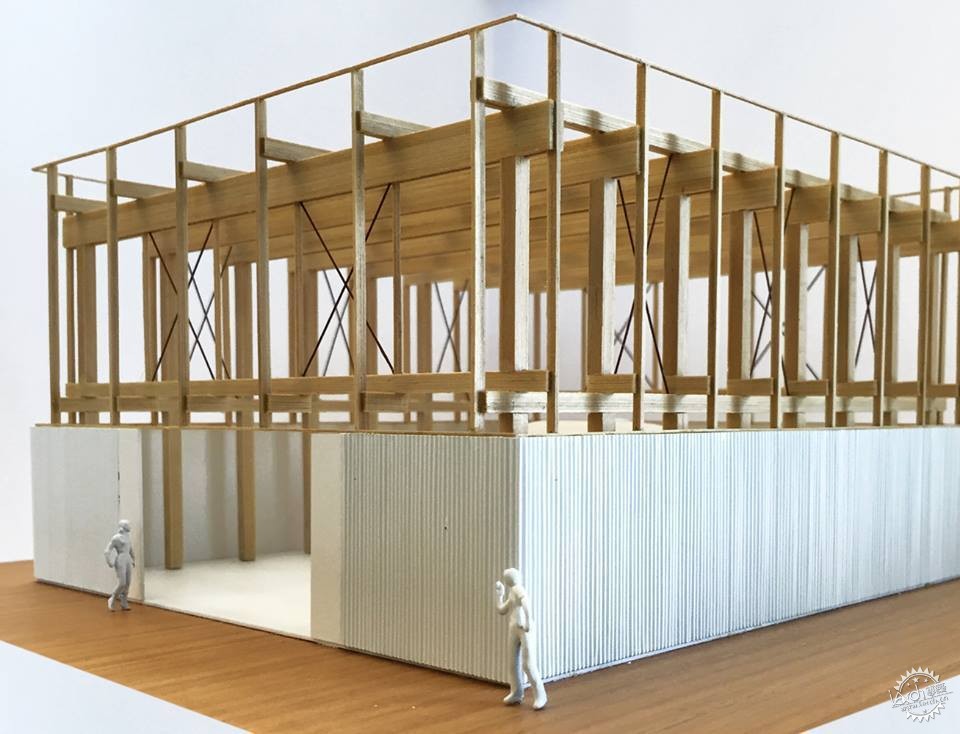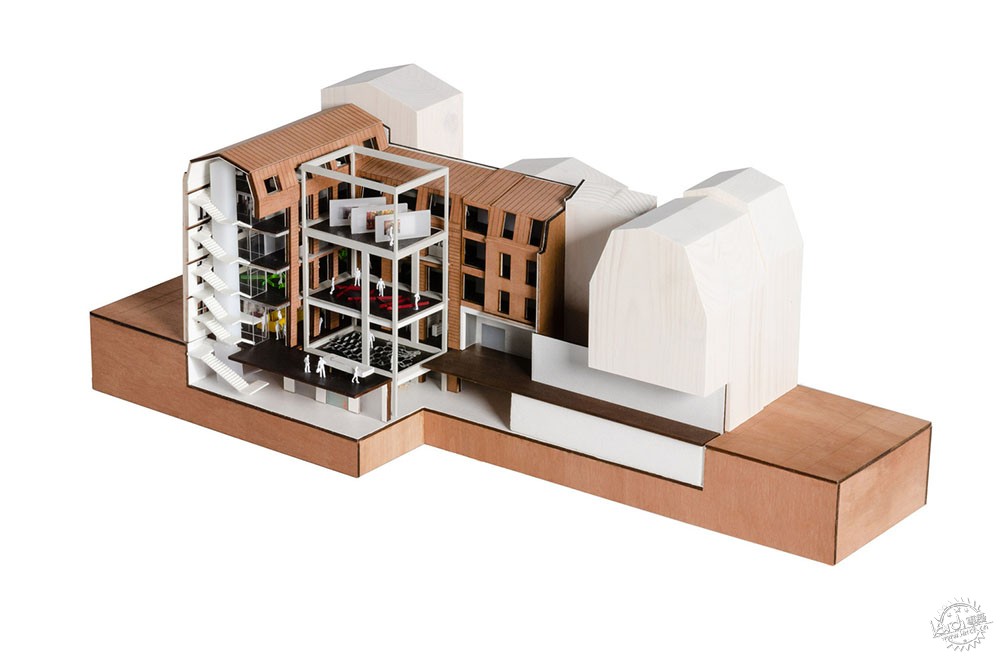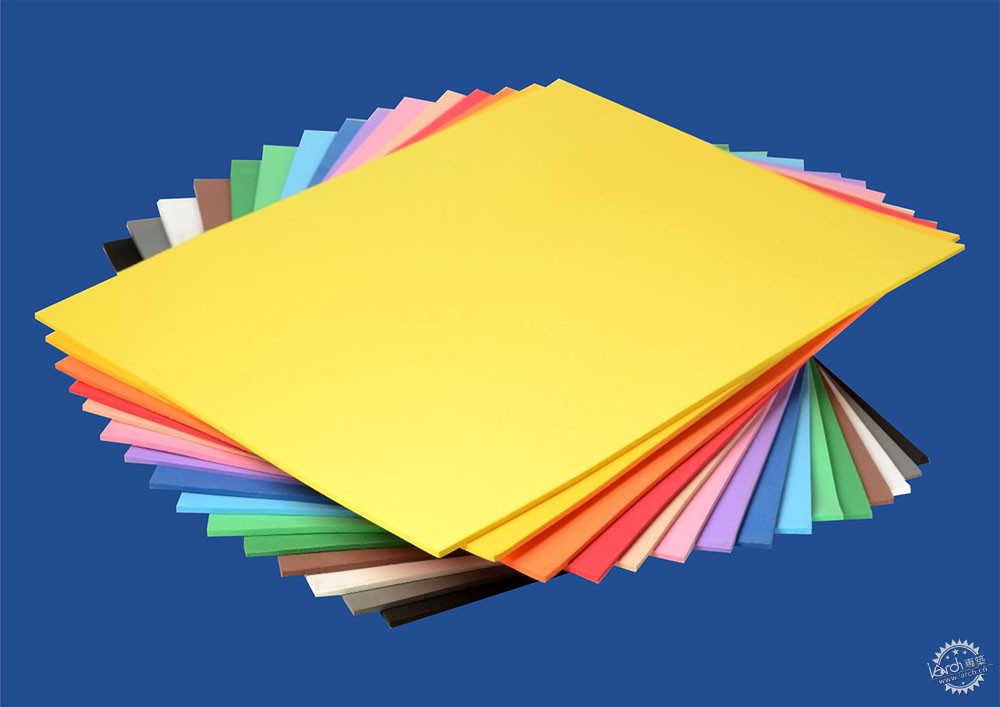
Casa no Pomar / ŠéPKA ARCHITEKTI
建筑模型最佳材料
The Best Materials for Architectural Models
由专筑网邢子,李韧编译
几个世纪以来,物理建模一直是建筑教育和实践的关键内容。这可以让设计师和客户同时在平面、立面和透视的角度中探索方案,物理模型的目的是模拟体量之间的空间关系并理解构造系统。
即使在超高质量渲染和虚拟现实的时代,物理材料模型也代表了在设计过程和表达阶段都能传达想法、且久经考验的方法。无论是通过对纸制模型的快速体量推敲,还是精心制作的木材构造细节,仔细的材料选择都可以极大地帮助建模过程,使设计师能够保持抽象思维,还能推敲结构系统的物理性能。
For centuries, physical modeling has been a staple of architectural education and practice. Allowing the designer and client to explore a scheme in plan, elevation, and perspective all at once, the physical model aims to simulate the spatial relationship between volumes and to understand constructive systems.
Even in an age of ultra-high quality rendering, and virtual reality, physical material models represent a beloved, tried and tested method of conveying ideas both during the design process and at presentation stage. Whether through a rapid, five-minute volumetric test of paper models, or a carefully sculpted timber construction detail, careful choice of material can greatly assist the modeling process, allowing designers to remain abstract, or test physical properties of structural systems.

midiateca PUC / SPBR
作为创作过程中的关键步骤,体量的探索对项目设计至关重要。想想安东尼•高迪的作品,二维图纸(平面图和剖面图)与物理模型共同作用,为设计提供了全面的展示。
As a crucial step in the creative process, volumetric explorations can be crucial to the design of a project. Think of the works of Antoni Gaudí. Two-dimensional drawings (plans and sections) work together with physical models to provide a comprehensive representation of the design.

Reprodução fac-símile do modelo polifunular de Colonia Güell. Image via Wikipedia user: SecondNews licensed under CC BY-SA 3.0
但是,建筑师Paulo Mendes da Rocha在巴西著作《Maquetes de Papel》中却声称模型可以有效支持设计系统,并非只是为了展示。
“这是草图模型......你所做的模型就是你所写的一篇文章......就像画家在绘画......这里的模型是一种工具,是工作过程的一部分。”(第22页)
But, architect Paulo Mendes da Rocha, in the Brazilian book "Maquetes de Papel" purports that models serve as support for the process, not for representation.
"It is the model as sketches ... The model you do as an essay of what you are imagining ... Like the poet when he scribbles, when he takes notice ... The model here is an instrument that is part of the work process. "(p.22)

OcupaçãoPMR - maquete reservatório de Urania foto: André Seiti
考虑到在建筑模型创建过程中出现的困难,我们收集了一套基本技巧和材料建议,希望可以在以后的建模过程中帮助到你。
Considering the challenges that arise during the creation of architectural models, we have compiled a set of fundamental tips and materials suggestions to assist you in your next modeling venture.
纸质模型
PAPER MODELS
亚硫酸纸

Papel sulfite. Image © ArchDaily Brasil
由于其成本较低,且容易获得,该材料最适合体量的推敲以及图纸平面的绘制。使用剪刀和胶带,就可以快速、轻松且经济高效地构思许多设计方案,同时可创建动态的建筑对象。
另一个需要考虑的特性是纸质模型的薄度和灵活性,它可以适应无应力的曲折、弯曲和倾斜。 这也使该材料适合折叠研究。
Sulphite Paper
Thanks to its low cost and accessibility this material is most suitable for rapid volumetric testing or drawing of design plans. With scissors and some tape, you can generate a number of solutions quickly, easily, and cost-effectively, while still creating dynamic architectural objects.
Another feature to be considered is the thinness and, consequently, flexibility of paper models, which allows stress-free bends, curves, and inclinations. This also makes the material good for folding studies.
卡板

Plano Urbanístico Parque Dom Pedro II / Una Arquitetos
与纸张相比,这种材料具有厚一些的边缘和刚性,因此经常用于没有明显三维曲线形状的建筑体量。然而值得注意的是,在某些情况下,曲面同样可以通过在边缘固定切口来实现。
Card Stock
This material, when compared to paper, offers a thicker edge and rigidity, and is therefore frequently used for the volumetric experimentation of architectural objects with shapes without large three-dimensional curves. However, it is worth noting that in some cases, curved surfaces can be achieved by fastening cuts at the edges.

Papel cartão. Image © ArchDaily Brasil
卡板具有多种颜色,也具有优秀的特性可以用于制作场地模型。用中性基色到表示地形,可以使用预先选择的调色板来设计或表示城市结构,用以表达不同的用途和程序,从而更好地理解空间划分和建筑功能。
卡板还可以用于物理模型的部分推敲,例如使用白色等中性色,再借助手电筒之类的光源来表达阴影效果。
弗兰克•盖里使用过这种材料,他的标志性设计包括流体形式、扭曲的平面和曲线。盖里创造了自发光模型,这出现在2005年Sydney Pollack执导的影片《弗兰克•盖里的草图》中。
With a variety of colors, it also has excellent properties for site programming models. From a neutral base color to represent terrain, it is possible to design or represent the urban fabric using a pre-established color palette to indicate different uses and programs, allowing for a better understanding of spatial division and the uses of the buildings.
Card stock also allows for the design of isolated physical models. Using neutral colors (particularly white) it becomes possible to understand the effect of shadows with the aid of a light source such as a flashlight.
Frank Gehry uses this material; his signature designs include fluid forms, twisted planes and curves. He creates spontaneous models, as seen in Sketches of Frank Gehry (2005), directed by Sydney Pollack.

Screenshot do documentário "Sketches of Frank Gehry"
纸板/芯片板

Campus da Universidade de Bocconi / SANAA
这种纸具有更高的重量和强度。双工板和三工板的区别是指每个板中的层数。该材料被理想地用于体量实体模型的制作。
建筑师Paulo Mendes da Rocha非常擅长使用这种材料,因为它的简单性和较快的制作速度。
Paper Board / Chip Board
This paper has an even higher weight and strength. The difference between duplex and triplex board refers to the amount of layers in each. The material is ideally used in the development of volumetric mock-ups.
The architect Paulo Mendes da Rocha is adept at using this material for its simplicity and experimental speed.

Papéis Duplex e Triplex. Image © ArchDaily Brasil
值得一提的是,上述所提到的纸可以结合一些额外的材料,例如醋酸纤维板,来表达镜面和玻璃的效果。
It is worth mentioning that, together with the papers mentioned, some additional materials can be used, such as acetate sheets, to represent glass and glazing.

River / SANAA
木质模型
WOOD MODELS
筏木

Madeira balsa. Image © ArchDaily Brasil
与纸质模型不同,木质模型有着更高的阻力和更好的细节层次。有了这一点,人们也能够以美观的方式来表现构造技术和空间属性,尽管这种方式的花费较高。
Madeira balsa
Unlike paper models, wood models provide higher resistance and a greater level of detail. With this, one is also able to represent constructive techniques and spatial properties in an aesthetically-pleasing, although typically more expensive manner.

Residência Itahye / Apiacás Arquitetos
在模型制作经常使用的木材系列中,筏木是最容易使用的木材,其厚度较小,因此能够用木材或白色胶水精确切割和连接表面。话虽如此,在垂直于纹理切片时必须小心注意,避免造成碎裂或粗糙的边缘。
Within the family of wood used frequently in model making, Balsa is the one of the easiest to work with. The low thickness allows for precise cutting and joining of surfaces with wood or white glue. That being said, careful attention must be given when slicing perpendicular to the grain, to avoid chipping, or rough edges.

Micasa Volume C / Studio MK27
许多工作室采用这种模型来观察建筑内部的构造解决方案。柔软的木材美学也以一种深思熟虑、自信、专业的方法向客户展示设计方案。
Many studios employ this model type for observing the constructive solutions in their interiors. The soft timber aesthetic also makes a great choice for presenting design proposals to the client in a considered, confident, professional methodology.

Galeries Lafayette / OMA
筏木在堆叠时也非常适合描绘轮廓线。除非你的目的就是考验自己的切割技术,否则最好使用激光切割机。
Balsa is also excellent for portraying contour lines when stacked. Unless you want to really put your cutting skills to the test, it's probably best to employ a laser cutter.

Sesc 24 de Maio / Paulo Mendes da Rocha + MMBB
筏木也非常适合通过打磨边缘、涂漆来制作不同的饰面。筏木通常用作面板或薄条,可以在包层、框架、薄板和瓷砖材质方面进行试验。
Balsa also lends itself excellently to manipulation through sanding of edges, painting, or varnishing to create different finishes. Balsa is typically available as panels, or thin strips, allowing for experimentation in cladding, framing, sheets, and tiling.
泡沫模型
FOAM MODELS

Foam. Image © ArchDaily Brasil
泡沫是快速体量推敲的最佳选择,泡沫切割机现在是大学工作室的主要工具,它可以在几分钟内切割数十个体块,这使该技术成为大规模环境建模的理想选择,在这种情况下,模式和外观等细节则显得不那么重要。
使用雕刻工具,泡沫还可以形成更明确、更详细的雕塑形态,以及树木等景观。
Foam is an excellent choice for rapid volumetric testing, with a foam cutter now a staple of university studios. Dozens of volumes can be generated in minutes, making the technique ideal for large-scale context modeling, where details such as pattern and facades are not as important.
Using carving tools, foam also allows for the creation of more defined, detailed sculptures, and landscaping features such as trees.

E.V.A. Image © ArchDaily Brasil
染色材料的运用也有助于展示项目。与泡沫切割一样,需要注意避免燃烧或染色产生的烟雾扩散。胶水的选择也很重要,因为一些化学品可能会熔化泡沫,并削弱模型的刚性。
泡沫建模特别受大学生的欢迎,因为它成本低,容易获得,并且通过适当的效果处理就能产生美感。
在专业领域,建筑巨头BIG和OMA建筑事务所都使用过泡沫模型。
The possibility of dyeing the material also helps show schematization of the project. As with foam cutting, care is needed to avoid the spread of fumes from burning or dyeing the material. Choice of glue is also important, as some chemicals may melt the foam and weaken the model's rigidity.
Foam modeling is a favorite for university students in particular, due to its low cost, ready availability, and pleasing aesthetic when due care and attention is paid.
In the professional world, foam models are used by the architectural powerhouses Bjarke Ingels Group (BIG) and OMA.
塑料模型
PLASTIC MODELS

The Blue Planet / 3XN
这种低成本的材料经常用于地形模型的制作。你可以简单地将打印图纸固定在塑料上然后进行切割。
由于其厚度较薄,因此可能需要使用相同的切口连接多层塑料来达到所需的厚度。
This low-cost material is often used for the development of topographical mockups. You can simply fasten a printed drawing on top of the plastic and cut.
Due to its low thickness, it might be necessary to join more than one layer with the same cutout to reach the desired final height.

Museu de Arte Contemporanea Lusitania / Frederico Valsassina Arquitectos
塑料模型可以与3d打印模型结合使用,为精细的设计提供基础及背景。
Plastic models can be complemented with 3D-printed models, providing a base or context for more elaborate, detailed designs.
|
|
